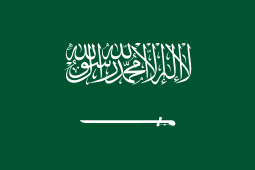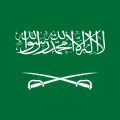
Najd is the central region of Saudi Arabia, in which about a third of the country's modern population resides. It is the home of the House of Saud, from which it pursued unification with Hejaz since the time of the Emirate of Diriyah.

The Hejaz is a region that includes the majority of the west coast of Saudi Arabia, covering the cities of Mecca, Medina, Jeddah, Tabuk, Yanbu, Taif and Baljurashi. It is thus known as the "Western Province", and it is bordered in the west by the Red Sea, in the north by Jordan, in the east by the Najd, and in the south by the Region of 'Asir. Its largest city is Jeddah, which is the second-largest city in Saudi Arabia, with Mecca and Medina, respectively, being the fourth- and fifth-largest cities in the country.

The national flag of the Islamic Emirate of Afghanistan, adopted on 15 August 2021 following the Taliban's victory in the 2001–2021 war, features a white field with a black Shahada inscribed. Since the 20th century, Afghanistan has changed its national flag several times. The national flag had black, red and green colors most of the time during the period.

The House of Saud is the ruling royal family of Saudi Arabia. It is composed of the descendants of Muhammad bin Saud, founder of the Emirate of Diriyah, known as the First Saudi state (1727–1818), and his brothers, though the ruling faction of the family is primarily led by the descendants of Abdulaziz bin Abdul Rahman, the modern founder of Saudi Arabia. It forms a subtribe of the larger prominent ancient Banu Hanifa tribe of Arabia, from which well known 7th century Arabian theologist Maslama ibn Ḥabīb originates. The most influential position of the royal family is the King of Saudi Arabia, an absolute monarch. The family in total is estimated to comprise 15,000 members; however, the majority of power, influence and wealth is possessed by a group of about 2,000 of them. Some estimates of the royal family's wealth measure their net worth at $1.4 trillion.This figure includes the market capitalization of Saudi Aramco, the state oil and gas company, and its vast assets in fossil fuel reserves, making them the wealthiest family in the world and the wealthiest in recorded history.

The flag of the United Arab Emirates contains the Pan-Arab colors red, green, white, and black. It was designed in 1971 by Abdullah Mohammed Al Maainah, who was 19 years old at that time, and was adopted on 2 December 1971 after winning a nationwide flag design contest. The main theme of the flag's four colors is the sovereignty and unity of the Arab states.
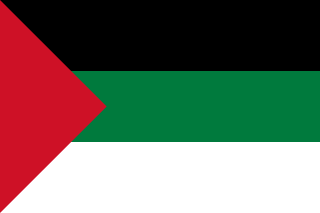
The pan-Arab colors are black, white, green and red. Individually, each of the four pan-Arab colors were intended to represent a certain aspect of the Arab people and their history.
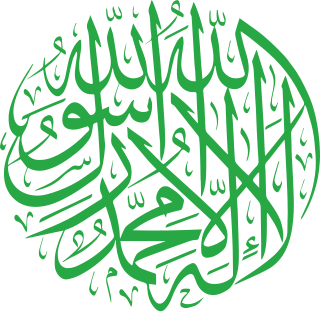
Islam is an Abrahamic monotheistic religion teaching that there is only one God and that Muhammad is the last messenger of God. It is the world's second-largest religion, with over 1.9 billion followers, and Muslims form 24.4% of the world's population.
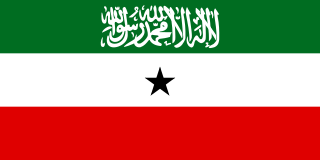
The flag of Somaliland was adopted on 14 October 1996. It consists of a tricolour of green, white, and red, with a black star located in the centre. On the green stripe, there is the Shahada in white calligraphic script.
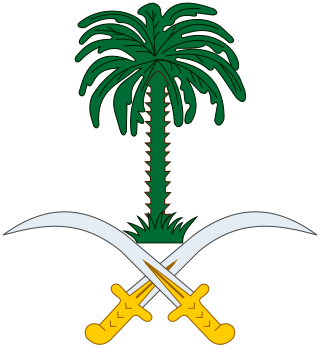
The Saudi Arabian national emblem was adopted in 1950. According to the Saudi Basic Law, it consists of two crossed swords with a palm tree in the space above and between the blades.

An Islamic flag is the flag either representing an Islamic Caliphate, religious order, state, civil society, military force or other entity associated with Islam. Islamic flags have a distinct history due to the Islamic prescription on aniconism, making particular colours, inscriptions or symbols such as crescent-and-star popular choices. Since the time of the Islamic prophet Muhammad, flags with certain colours were associated with Islam according to the traditions. Since then, historical Caliphates, modern nation states, certain denominations as well as religious movements have adopted flags to symbolize their Islamic identity. Some secular states and ethnic or national movements also use symbols of Islamic origin as markers of heritage and identity.

The Saudi–Yemeni war was a war between Saudi Arabia and the Kingdom of Yemen in 1934.

The Unification of Saudi Arabia was a military and political campaign in which the various tribes, sheikhdoms, city-states, emirates, and kingdoms of most of the central Arabian Peninsula were conquered by the House of Saud, or Al Saud. Unification started in 1902 and continued until 1932, when the Kingdom of Saudi Arabia was proclaimed under the leadership of Abdulaziz, known in the West as Ibn Saud, creating what is sometimes referred to as the Third Saudi State, to differentiate it from the Emirate of Diriyah, the First Saudi State and the Emirate of Nejd, the Second Saudi State, also House of Saud states.
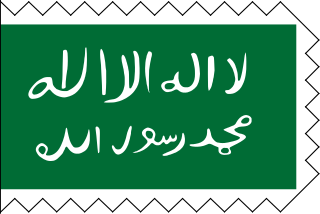
The Idrisid Emirate of Asir was a state located in the Arabian Peninsula. The Emirate was in the geographical region of Asir and Jizan, in what is now southwestern Saudi Arabia, and extending to Hodeidah, northwest of Yemen.
The Shahada, also transliterated as Shahadah, is an Islamic oath and creed, and one of the Five Pillars of Islam and part of the Adhan. It reads: "I bear witness that there is no deity but God, and I bear witness that Muhammad is the Messenger of God."
The First Saudi–Hashemite War, also known as the First Nejd–Hejaz War or the al-Khurma dispute, took place in 1918–19 between Abdulaziz Ibn Saud of the Emirate of Nejd and Hasa and the Hashemites of the Kingdom of Hejaz.

The King of Saudi Arabia, officially the King of the Kingdom of Saudi Arabia, is the monarch and head of state/government of the Kingdom of Saudi Arabia who holds absolute power. He is the head of the Saudi Arabian royal family, the House of Saud. The king is the supreme commander-in-chief of the Royal Saudi Armed Forces and the head of the Saudi national honors system. The king is called the "Custodian of the Two Holy Mosques", a title that signifies Saudi Arabia's jurisdiction over the mosques of Masjid al-Haram in Mecca and Al-Masjid an-Nabawi in Medina. The title has been used many times through the history of Islam. The first Saudi king to use the title was Faisal; however, King Khalid did not use the title after him. In 1986, King Fahd replaced "His Majesty" with the title of Custodian of the Two Holy Mosques, and it has been since used by both King Abdullah and King Salman. The king has been named the most powerful and influential Muslim and Arab leader in the world according to the Muslim 500.

The Ottoman era in the history of Arabia lasted from 1517 to 1918. The Ottoman degree of control over these lands varied over these four centuries, with the fluctuating strength or weakness of the Empire's central authority.

The crown prince of Saudi Arabia is the second-most important position in Saudi Arabia, second to the King, and is his designated successor. Currently, the Crown Prince assumes power with the approval of the Allegiance Council after he is nominated by the King. This system was introduced to the country during the reign of King Abdullah. In the absence of the King, an order is issued to have the Crown Prince manage the affairs of the state until the King's return.

The Declaration of theUnification of Saudi Arabia was officially announced by Prince Faisal bin Abdulaziz, the Viceroy of Hejaz on behalf of King Abdulaziz ibn Saud on September 23, 1932, at 9:00 am from al-Hamidiyah Palace in Mecca. Faisal read out the Royal Decree No. 2716 issued by Abdulaziz ibn Saud on September 18, 1932, that renamed the Kingdom of Hejaz and Nejd and its annexes as the Kingdom of Saudi Arabia.
